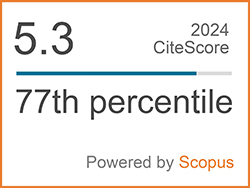Fabrication and Experimental Testing of Hybrid Composite Material Having Biodegradable Bagasse Fiber in a Modified Epoxy Resin: Evaluation of Mechanical and Morphological Behavior
Abstract
Keywords
[1] S. W. Zhang, “State-of-the-art of polymer tribology,” Tribology International, vol. 31, no. 1–3, pp. 49–60, 1998.
[2] C. Girisha, G. Sanjeevamurthy, and G. R. Srinivas, “Sisal/coconut coir natural fibers-epoxy composites: Water absorption and mechanical properties,” International Journal of Engineering and Innovative Technology, vol. 2, pp. 166–170, 2012.
[3] A. Verma, A. Parashar, and M. Packirisamy, “Atomistic modeling of graphene/hexagonal boron nitride polymer nanocomposites: A review,” Wiley Interdisciplinary Reviews: Computational Molecular Science, vol. 8, no. 3, p. e1346, 2018.
[4] A. Verma, V. K. Singh, S. K. Verma, and A. Sharma, “Human hair: A biodegradable composite fiber–A review,” International Journal of Waste Resources, vol. 6, no. 206, p. 2, 2016.
[5] A. Verma, A. Gaur, and V. K. Singh, “Mechanical properties and microstructure of starch and sisal fiber biocomposite modified with epoxy resin,” Materials Performance and Characterization, vol. 6, no. 1, pp. 500–520. 2017.
[6] K. N. Bharath, P. Madhu, T. G. Gowda, A. Verma, M. R. Sanjay, and S. Siengchin, “A novel approach for development of printed circuit board from biofiber based composites,” Polymer Composites, vol. 41, no. 11, pp. 4550–4558. 2020.
[7] A. Verma, P. Negi, and V. K. Singh, “Experimental analysis on carbon residuum transformed epoxy resin: Chicken feather fiber hybrid composite,” Polymer Composites, vol. 40, no. 7, pp. 2690– 2699, 2019.
[8] A. Verma and V. K. Singh, “Mechanical, microstructural and thermal characterization of epoxy-based human hair–reinforced composites,” Journal of Testing and Evaluation, vol. 47, no. 2, pp. 1193–1215, 2019.
[9] A. Verma, P. Negi, and V. K. Singh, “Physical and thermal characterization of chicken feather fiber and crumb rubber reformed epoxy resin hybrid composite,” Advances in Civil Engineering Materials, vol. 7, no. 1, pp. 538–557, 2018.
[10] A. Verma, P. Negi, and V. K. Singh, “Experimental investigation of chicken feather fiber and crumb rubber reformed epoxy resin hybrid composite: Mechanical and microstructural characterization,” Journal of the Mechanical Behavior of Materials, vol. 27, no. 3–4, 2018.
[11] A. Verma, L. Budiyal, M. R. Sanjay, and S. Siengchin, “Processing and characterization analysis of pyrolyzed oil rubber (from waste tires)‐epoxy polymer blend composite for lightweight structures and coatings applications,” Polymer Engineering and Science, vol. 59, no. 10, pp. 2041–2051, 2019.
[12] N. Jain, A. Verma, and V. K. Singh, “Dynamic mechanical analysis and creep-recovery behaviour of polyvinyl alcohol based cross-linked biocomposite reinforced with basalt fiber,” Materials Research Express, vol. 6, no. 10, p. 105373, 2019.
[13] A. Verma, C. Singh, V. K. Singh, and N. Jain, “Fabrication and characterization of chitosancoated sisal fiber–Phytagel modified soy proteinbased green composite,” Journal of Composite Materials, vol. 53, no. 18, pp. 2481–2504, 2019.
[14] A. Verma, K. Joshi, A. Gaur, and V. K. Singh, “Starch-jute fiber hybrid biocomposite modified with an epoxy resin coating: Fabrication and experimental characterization,” Journal of the Mechanical Behavior of Materials, vol. 27, no. 5–6, 2018.
[15] A. Verma, K. Baurai, M. R. Sanjay, and S. Siengchin, “Mechanical, microstructural, and thermal characterization insights of pyrolyzed carbon black from waste tires reinforced epoxy nanocomposites for coating application,” Polymer Composites, vol. 41, no. 1, pp. 338–349, 2020.
[16] A. Verma, R. Kumar, and A. Parashar, “Enhanced thermal transport across a bi-crystalline graphene– polymer interface: an atomistic approach,” Physical Chemistry Chemical Physics, vol. 21, no. 11, pp. 6229–6237, 2019.
[17] A. Chaurasia, A. Verma, A. Parashar, and R. S. Mulik, “Experimental and computational studies to analyze the effect of h-BN nanosheets on mechanical behavior of h-BN/polyethylene nanocomposites,” The Journal of Physical Chemistry C, vol. 123, no. 32, pp. 20059–20070, 2019.
[18] A. Verma, A. Parashar, and M. Packirisamy, “Effect of grain boundaries on the interfacial behaviour of graphene-polyethylene nanocomposite,” Applied Surface Science, vol. 470, pp. 1085–1092, 2019.
[19] S. Rastogi, A. Verma, and V. K. Singh, “Experimental response of nonwoven waste cellulose fabric–reinforced epoxy composites for high toughness and coating applications,” Materials Performance and Characterization, vol. 9, no. 1, pp. 151–172, 2020.
[20] A. Verma, A. Parashar, N. Jain, V. K. Singh, S. M. Rangappa, and S. Siengchin, “Surface modification techniques for the preparation of different novel biofibers for composites,” in Biofibers and Biopolymers for Biocomposites. Switzerland: Springer Nature, 2020, pp. 1–34.
[21] M. K. Marichelvam, P. Manimaran, A. Verma, M. R. Sanjay, S. Siengchin, K. Kandakodeeswaran, and M. Geetha, “A novel palm sheath and sugarcane bagasse fiber based hybrid composites for automotive applications: An experimental approach,” Polymer Composites, vol. 42, no. 1, pp. 512–521, 2021.
[22] A. Verma, N. Jain, A. Parashar, A. Gaur, M. R. Sanjay, and S. Siengchin, “Lifecycle assessment of thermoplastic and thermosetting bamboo composites,” in Bamboo Fiber Composites. Singapore: Springer, 2020, pp. 235–246.
[23] K. N. Bharath, P. Madhu, T. Y. Gowda, A. Verma, M. R. Sanjay, and S. Siengchin, “Mechanical and chemical properties evaluation of sheep wool fiber–reinforced vinylester and polyester composites,” Materials Performance and Characterization, vol. 10, no. 1, pp. 99–109, 2021.
[24] S. M. Rangappa, S. Siengchin, and H. N. Dhakal, “Green-composites: Ecofriendly and sustainability,” Applied Science and Engineering Progress, vol. 13, no. 3, pp. 183–184, 2020.
[25] M. Jawaid and S. Siengchin, “Hybrid composites: A versatile materials for future,” Applied Science and Engineering Progress, vol. 12, no. 4, p. 223, 2019.
[26] S. M. K. Thiagamani, S. Krishnasamy, and S. Siengchin, “Challenges of biodegradable polymers: An environmental perspective,” Applied Science and Engineering Progress, vol. 12, no. 3, p. 149, 2019.
[27] Y. G. T. Girijappa, S. M. Rangappa, J. Parameswaranpillai, and S. Siengchin, “Natural fibers as sustainable and renewable resource for development of eco-friendly composites: A comprehensive review,” Frontiers in Materials, vol. 6, p. 226, 2019. [28] A. Vinod, M. R. Sanjay, S. Suchart, and P. Jyotishkumar, “Renewable and sustainable biobased materials: An assessment on biofibers, biofilms, biopolymers and biocomposites,” Journal of Cleaner Production, vol. 258, p. 120978, 2020.
[29] M. R. Sanjay, S. Siengchin, J. Parameswaranpillai, M. Jawaid, C. I. Pruncu, and A. Khan, “A comprehensive review of techniques for natural fibers as reinforcement in composites: Preparation, processing and characterization,” Carbohydrate Polymers, vol. 207, pp. 108–121, 2019.
[30] M. R. Sanjay, P. Madhu, M. Jawaid, P. Senthamaraikannan, S. Senthil, and S. Pradeep, “Characterization and properties of natural fiber polymer composites: A comprehensive review,” Journal of Cleaner Production, vol. 172, pp. 566–581, 2018.
[31] G. Rajeshkumar, V. Hariharan, S. Indran, M. R. Sanjay, S. Siengchin, J. P. Maran, N. A. Al-Dhabi, and P. Karuppiah, “Influence of sodium hydroxide (NaOH) treatment on mechanical properties and morphological behaviour of Phoenix sp. fiber/ epoxy composites,” Journal of Polymers and the Environment, vol. 29, pp. 765–774, 2021.
[32] A. Verma, W. Zhang, and A. C. T. van Duin, “ReaxFF reactive molecular dynamics simulations to study the interfacial dynamics between defective h-BN nanosheet and water nanodroplets,” Physical Chemistry Chemical Physics, vol. 23, pp.10822– 10834, 2021.
DOI: 10.14416/j.asep.2021.06.002
Refbacks
- There are currently no refbacks.
 Applied Science and Engineering Progress
Applied Science and Engineering Progress







